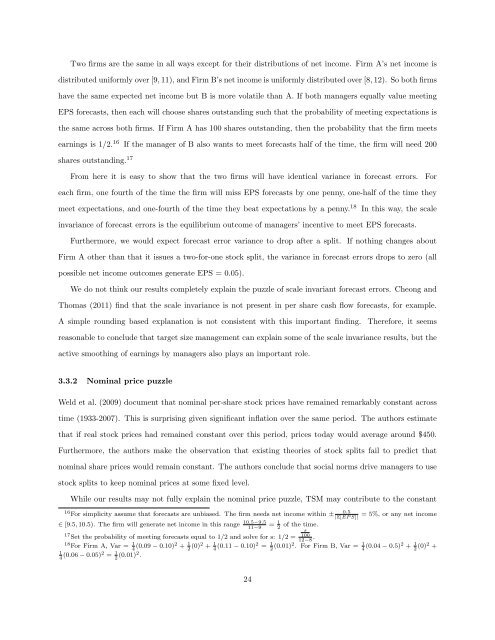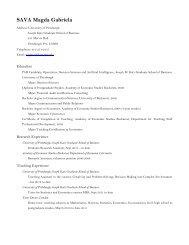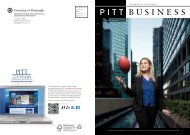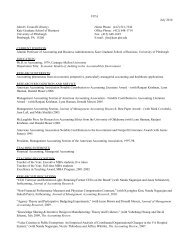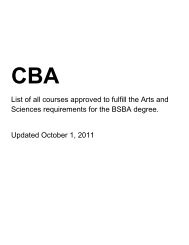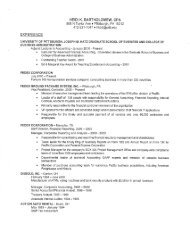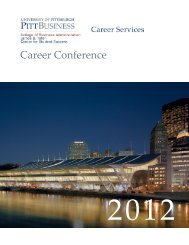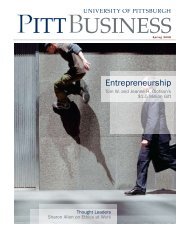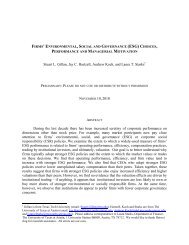Gaming the Float: How Managers Respond to EPS-based Incentives
Gaming the Float: How Managers Respond to EPS-based Incentives
Gaming the Float: How Managers Respond to EPS-based Incentives
Create successful ePaper yourself
Turn your PDF publications into a flip-book with our unique Google optimized e-Paper software.
Two firms are <strong>the</strong> same in all ways except for <strong>the</strong>ir distributions of net income. Firm A’s net income is<br />
distributed uniformly over [9, 11), and Firm B’s net income is uniformly distributed over [8, 12). So both firms<br />
have <strong>the</strong> same expected net income but B is more volatile than A. If both managers equally value meeting<br />
<strong>EPS</strong> forecasts, <strong>the</strong>n each will choose shares outstanding such that <strong>the</strong> probability of meeting expectations is<br />
<strong>the</strong> same across both firms. If Firm A has 100 shares outstanding, <strong>the</strong>n <strong>the</strong> probability that <strong>the</strong> firm meets<br />
earnings is 1/2. 16 If <strong>the</strong> manager of B also wants <strong>to</strong> meet forecasts half of <strong>the</strong> time, <strong>the</strong> firm will need 200<br />
shares outstanding. 17<br />
From here it is easy <strong>to</strong> show that <strong>the</strong> two firms will have identical variance in forecast errors.<br />
For<br />
each firm, one fourth of <strong>the</strong> time <strong>the</strong> firm will miss <strong>EPS</strong> forecasts by one penny, one-half of <strong>the</strong> time <strong>the</strong>y<br />
meet expectations, and one-fourth of <strong>the</strong> time <strong>the</strong>y beat expectations by a penny. 18<br />
In this way, <strong>the</strong> scale<br />
invariance of forecast errors is <strong>the</strong> equilibrium outcome of managers’ incentive <strong>to</strong> meet <strong>EPS</strong> forecasts.<br />
Fur<strong>the</strong>rmore, we would expect forecast error variance <strong>to</strong> drop after a split. If nothing changes about<br />
Firm A o<strong>the</strong>r than that it issues a two-for-one s<strong>to</strong>ck split, <strong>the</strong> variance in forecast errors drops <strong>to</strong> zero (all<br />
possible net income outcomes generate <strong>EPS</strong> = 0.05).<br />
We do not think our results completely explain <strong>the</strong> puzzle of scale invariant forecast errors. Cheong and<br />
Thomas (2011) find that <strong>the</strong> scale invariance is not present in per share cash flow forecasts, for example.<br />
A simple rounding <strong>based</strong> explanation is not consistent with this important finding.<br />
Therefore, it seems<br />
reasonable <strong>to</strong> conclude that target size management can explain some of <strong>the</strong> scale invariance results, but <strong>the</strong><br />
active smoothing of earnings by managers also plays an important role.<br />
3.3.2 Nominal price puzzle<br />
Weld et al. (2009) document that nominal per-share s<strong>to</strong>ck prices have remained remarkably constant across<br />
time (1933-2007). This is surprising given significant inflation over <strong>the</strong> same period. The authors estimate<br />
that if real s<strong>to</strong>ck prices had remained constant over this period, prices <strong>to</strong>day would average around $450.<br />
Fur<strong>the</strong>rmore, <strong>the</strong> authors make <strong>the</strong> observation that existing <strong>the</strong>ories of s<strong>to</strong>ck splits fail <strong>to</strong> predict that<br />
nominal share prices would remain constant. The authors conclude that social norms drive managers <strong>to</strong> use<br />
s<strong>to</strong>ck splits <strong>to</strong> keep nominal prices at some fixed level.<br />
While our results may not fully explain <strong>the</strong> nominal price puzzle, TSM may contribute <strong>to</strong> <strong>the</strong> constant<br />
16 For simplicity assume that forecasts are unbiased. The firm needs net income within ± 0.5 = 5%, or any net income<br />
|E[EP S]|<br />
∈ [9.5, 10.5). The firm will generate net income in this range 10.5−9.5 = 1 of <strong>the</strong> time.<br />
11−9 2<br />
s<br />
17 Set <strong>the</strong> probability of meeting forecasts equal <strong>to</strong> 1/2 and solve for s: 1/2 = 100<br />
12−8 .<br />
18 For Firm A, Var = 1 4 (0.09 − 0.10)2 + 1 2 (0)2 + 1 4 (0.11 − 0.10)2 = 1 2 (0.01)2 . For Firm B, Var = 1 4 (0.04 − 0.5)2 + 1 2 (0)2 +<br />
1<br />
4 (0.06 − 0.05)2 = 1 2 (0.01)2 .<br />
24


